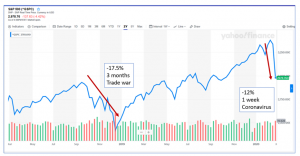The Coronavirus Correction
It has been a difficult week for investors after troubling news last weekend regarding the spread of Coronavirus beyond China. Risks of this disease turning into a global pandemic have worried investors. Since hitting an all-time high on February 19th, the S&P 500 has dropped by 12.04% – its worst weekly decline since 2008. It is important for us to communicate to our clients how we view the situation and what we are doing about it.
We are monitoring the situation closely but are not making any knee-jerk reactions. We invest proactively. Our portfolios are conservatively allocated, and designed to withstand such market corrections. As the S&P 500 increased over 30% last year, we rebalanced multiple times to take profits from equities and reallocate those funds back into bonds. Furthermore, we go to great lengths to ensure that our clients are in the correct risk profiles so that periods of short-term volatility do not jeopardize their financial goals.
The Basics
What we are calling Coronavirus is actually one of many different strains of Coronavirus, specifically called Coronavirus Disease 2019 or Covid19. The other known Coronavirus strains include SARS (Severe Acute Respiratory Syndrome), MERS (Middle East Respiratory Syndrome) and several others that are often just referred to as the common cold.
By way of comparison, the annual flu has a mortality rate of about 0.2% while Covid19 appears to be lethal in about 2-4% of cases. SARS had a fatality rate of 10%, while MERS was somewhere between 30-40%. The numbers from Covid19 are also highly age-dependent. Older patients are at much higher risk, while children seem incredibly resistant. In the uncommon cases studied where children were tested positive, most were almost completely asymptomatic (it barely affected them).
As of this writing, 82,000 cases and 3,000 deaths have been confirmed. The virus has affected 6 continents, 37 countries, and a cruise liner (where it infected over 700 passengers). As the threat has escalated, countries are aggressively imposing travel bans, transportation closures, and mandatory testing on citizens.
Most analysts are saying a disruption in economic activity and global supply chains is the most likely effect of this outbreak. After the news of a breakout in Italy how many people will cancel travel plans to Venice? China has already shut down KFC restaurants, Starbucks, auto plants, and other factories. Japan has closed most of its schools. Switzerland just canceled the Geneva International Car Show, Facebook has recently canceled its developer conference, and Microsoft indicated that Coronavirus will impact earnings on its windows-based products. On an even bigger scale, The International Olympic Committee has stated that it will have to decide in May whether or not the 2020 Olympic Games will take place in Tokyo as scheduled. These are major disruptions to global economic activity.
What are the possible market impacts?
With the S&P 500 index already down 12% from its all-time high in just a week, how much further could the market fall? The answer to that question depends on many factors. How quickly can effective treatment be developed? How well can global entities contain the spread? How will people adjust to a world on high alert, and how fast will things return to ‘normal’ once it passes. Companies like United Airlines, Microsoft, and Apple along with many others, are already reducing their earnings estimates for the year; citing the virus as a factor.
If the outbreak’s spread comes under control and/or an effective treatment is developed soon, markets could recover fairly quickly. We just don’t know enough about this virus yet to make any clear determinations on the likelihood of those things happening. In fact, one of the major reasons for the intensity of this sell-off has been that we do not have clear answers.
Looking forward
It will be instructive to continue watching China. China has reported fewer cases this week than last week and many of the quarantines on cities and industries have started to be lifted. Analysts have said that economic demand around the globe is still fairly strong, but there is some trouble getting people back into the factories that have reopened. Even after quarantines and closures are lifted, many of the citizens are playing it safe. That would be a good sign if that is what is causing bottlenecks in the supply chain.
We are carefully listening to the World Health Organization (WHO) and the Center for Disease Control (CDC) for their guidance on the situation. We are also looking at how companies are responding. Obviously, most companies will be (and should be!) putting employee’s safety first and foremost. We want to see what kind of guidance they are using and what that does to earnings forecasts.
The fears of this virus have also pushed investors into safe-haven assets, causing the 10-year treasury yield to fall to 1.20% (as of writing). Therefore, bonds have fulfilled their role of diversifier by performing well while stocks declined. Clients with meaningful bond allocations have been better insulated from market losses as a result.
The thing that should not be lost in this discussion is the human element. It is our job as fiduciaries to monitor and discuss the financial and investment implications of events around the world, however, our hearts go out to all the families around the world who have been impacted. We wish them peace and healing.
We appreciate the ongoing confidence of our clients and work hard every day to keep that honor. We will remain vigilant on this situation and let you know if anything changes.
If you have any questions, please feel free to contact us.
Keith J. Akre, CFA, CFP® – Vice President & Trust Officer
Opinions expressed are solely my own and do not express the views or opinions of Stillman Bank. Investments available through Stillman Trust & Wealth Management (1) are not FDIC insured (2) are not deposits, obligations, or guaranteed by the bank and (3) are subject to investment risk including possible loss of principal.



